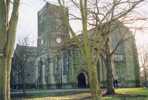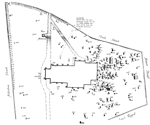 Sneinton Sneinton
St Stephen
Churchyard
Most of the paths surrounding the church are made from concrete or concrete
slabs. The main driveway into the churchyard was concreted recently. The southern
section of the old footpath is laid with compacted limestone. Some small areas
are still covered by the York stone paving, which for many years was used for
all the minor walkways.
The churchyard of St Stephen’s is a unique piece of land in the city.
It is about one and a half acres in size and has not been used for anything
other than church buildings and a burial ground for at least eight hundred
years and possibly longer. Pevsner refers to it as ‘a countrified churchyard’.
The present church sits more or less in the centre of the site surrounded
by weathered headstones and other memorials enclosed by walls on all four sides.
The north and west walls are built of three inch red bricks with saddleback
brick copings. The south and east walls are built in stone, some of which are
said to have been reclaimed from the medieval church, demolished in 1810. This
building was located in the southeast corner of the site close to the street
so it was likely that they were used to close the gap in the wall formed by
the old entrance. Stone from the 1810 church, demolished in 1839 was also used
to repair the walls.
A footpath dissects the site running from north (Sneinton Road) to south (Newark
Street), giving access to the west door of the church, with a smaller path
leading off to the north door and the north vestries. Currently the north entrance
is un-gated, but until a few years ago supported a pair of wrought iron gates.
The south entrance still has iron gates. For many years the pathway was closed
and the gates blocked by vegetation. The pathway is clearly visible on the 1796
Nottingham Enclosure map, which also shows the church of the day located
in the southeast corner of the site.
At the side of the path a large oak Calvary rises
from a stepped plinth of Ancaster stone, supporting a bronze figure of Christ.
Burials ceased in the early 1890s although a few interments were allowed in
family graves. In recent years the City council have taken responsibility for
the upkeep of the churchyard. Some older trees remain and a few young ones
have been planted by the Sneinton Environmental Society. The site is within
the Sneinton Conservation Area.
 Plan
of the churchyard Plan
of the churchyard
produced in 1987 by
Family First Trust |
In 1987 The Family First Trust, working as part of the Manpower Services Commission’s
Community Programme, conducted a survey of the headstones and memorials. At
that time 301 records were listed. Many of the stones had already been re-sited
to rest against the west and north boundary walls. The plan they produced shows
14 marked graves on the west side of the main pathway. In 2004 only 10 of these
14 remain in place. The oldest memorial recorded in 1987 was dated 1756, most
of the inscriptions are from the 19th century. Truman (1946) recorded the details
of a stone near the east end of the church dated July 1656 in memory of John
Kirkbee.
During a German air raid on the night of May 9th 1941 two bombs landed in
the churchyard. One penetrated the ground just inside the west boundary wall
to a depth of 12 feet, but did not detonate so it had to be removed. The other
fell and exploded near the south wall of the church damaging the windows and
starting a fire on the transept roof.
A small Garden of Remembrance has been created near the north door, for the
internment of cremated remains. Flat memorial stones can also be placed there.
On the wall adjacent this site a plaque has been fixed recording the names
of those remembered.
Notable burials and memorials:
In the non-conformist section of the churchyards northeast corner:
George
Green, Mathematician and local miller, Died 1841
Several of his family are also buried nearby.
| 


 Plan
of the churchyard
Plan
of the churchyard The
northern part,
The
northern part,
 The
southern part,
The
southern part, The
southern part,
The
southern part,





